Investing is, for sure, a hell of a task that may cause you to lose almost everything, but it’s also true that you will gain big if you get everything right. Perhaps this is why people all over the world “play their luck” in the stock and securities markets.
Why not lower your chances of losing money by studying the stock, analyzing it carefully, and understanding the risks involved? Even though we now have the internet (an amazing research tool), books still offer insights and depth that the web simply can’t match.
Without knowing what you are looking for, how can you maximize your profit? To help you with your investment plans and increase your knowledge about stock market investments, we have gathered some of the best investing books available.
Did you know?In Amazon’s “Bestseller in Investing” list, two titles that consistently rank among the top 10 are The Psychology of Money by Morgan Housel and The Intelligent Investor by Benjamin Graham
Table of Contents
17. The Book On Rental Property Investing
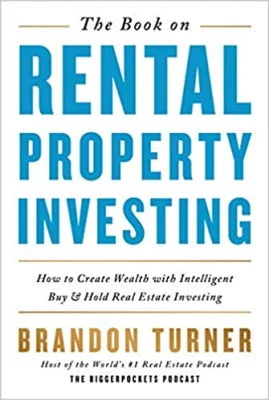
Author: Brandon Turner
Pages: 364
Best for: Real Estate Investing
Brandon Turner is a real estate investor and the founder of Open Door Capital LLC, a real estate investment firm that allows clients to invest in mobile home parks for risk-adjusted returns.
He also serves as the vice president (creative) at BiggerPockets.com, one of the largest online real estate investing communities.
In his award-winning book, “The Book on Rental Property Investing,” Turner outlines some of the most efficient strategies and practices employed by property investors worldwide. It could be your handy guide to finding lucrative deals in competitive markets and valid ways to finance them.
The book also does a good job of explaining why most real estate investors fail and how you can prevent yourself from being in that situation.
16. Options, Futures, and Other Derivatives
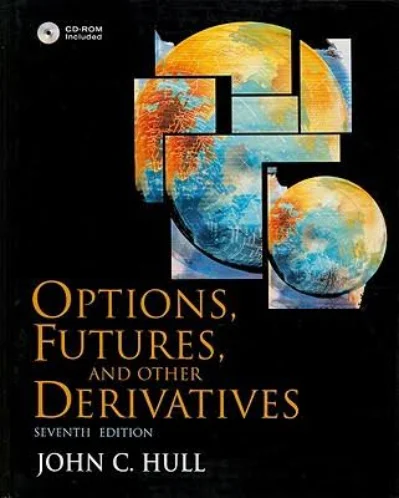
Author: John C. Hull
Pages: 816
Best for: Derivatives and Options Trading
For investors who trade in derivatives such as options and futures, John Hull’s book on Options, Futures, And Other Derivatives (OF&OD) is nothing less than a holy grail. Universally known simply as “Hull,” the book serves as an excellent starting point in the derivatives industry. And according to many, it’s a must-have book for every investor and finance professional.
OF&OD is written in clear, easy-to-understand language and is mostly thorough. It covers essential topics such as how commodity derivatives are valued, the credit crisis, overnight indexed swaps, and the Black-Scholes-Merton formula.
With this book, John Hull does a great job of offering readers a unique perspective on the modern derivative industry.
15. When Genius Failed: Best For Understanding Risk

Author: Roger Lowenstein
Pages: 264
Best for: Understanding Risk in the market
“When Genius Failed” encapsulates what happened at Long-Term Capital Management (LCTM), a hotshot hedge fund in the late 1990s, from its meteoric rise to its sudden downfall.
LTCM was founded in 1994 by John Meriwether, former head of bond trading at Solomon Brothers, alongside two Nobel Prize-winning economists, Robert Merton and Myron Scholes. Also aboard were a handful of MIT doctoral students who previously held reputable positions.
The star-studded management of LTCM convinced many industry experts and pundits of its imminent success as a major player.
However, after just three years of explosive growth (a 43% annual return in its second year), the fund went bust due to a combination of high leverage and exposure to financial crises in Asia between 1997 and 1998.
With the help of interviews with key members of the firm and dozens of internal memos, Roger Lowenstein’s book carefully dissects what went wrong at LCTM. It shows how greed and arrogance can cause a firm to lose billions of dollars in a few months.
14. Trade Your Way to the Financial Freedom
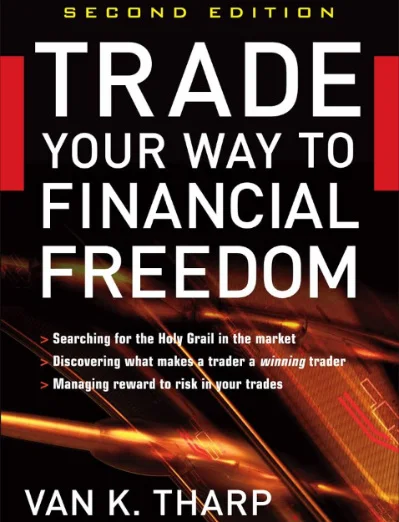
Author: Van K. Tharp
Pages: 482
Best for: Novice Traders
Although the terms ‘investing’ and ‘trading’ are used interchangeably, they are two completely different approaches. Investors place bets on the share market over long periods, whereas traders focus on short-term buying and selling.
“Trade Your Way To Financial Freedom” is for those who have picked up a serious interest in trading. The book features a number of ideas, references, and methods regarding trading. It also introduces the author’s multiple-step trading model, which focuses on the psychological aspects of stock trading, including how to create your own investment system.
13. Millionaire Teacher: Memoir

Author: Andrew Hallam
Pages: 184
Best for: Personal wealth management
“Millionaire Teacher” explains how Andrew Hallam, a school teacher, built a million-dollar portfolio by using low-cost index funds and following a value-investing approach.
The book explains why stock market crashes are actually healthy for your portfolio (buy the dip) and how, by spending just a small amount of time in the market, you can still keep up with most professionals.
12. Principles: Life And Work
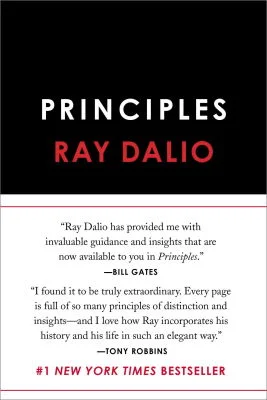
Author: Ray Dalio
Pages: 592
Best for Personal development in both life and business
Books are a great source of inspiration, and as a young and aspiring investor, it’s vital to choose the right book to do so. As far as inspirational books on investing go, you can’t possibly go wrong with Ray Dalio’s Principles: Life and Work.
Ray Dalio is the founder and co-chairman of Bridgewater Associates, the world’s largest hedge fund, with over $140 billion in assets under management. He is widely considered one of the world’s most successful investors.
The book highlights the key skills and life lessons Dalio learned throughout his remarkable investing career. It explains effective ways for individuals and companies to solve problems and make decisions. Dalio also shares the tools and methods used at his firm, which are built on the ideas of “radical truth” and “radical transparency.”
11. You Can Be a Stock Market Genius
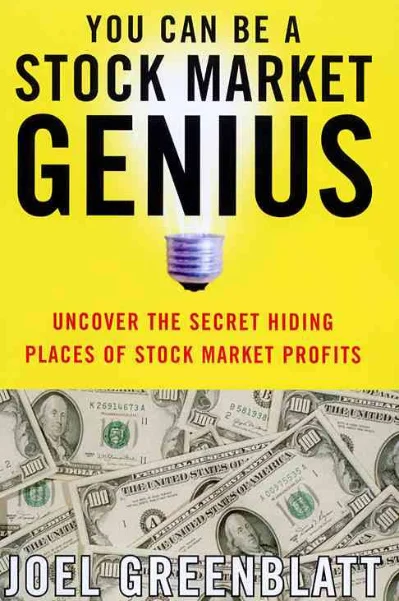
Author: Joel Greenblatt
Pages: 304
Best for: Value investors
Learning investment strategies from a hedge fund manager can be risky, but they also offer a unique perspective on equity markets and portfolio management. Joel Greenblatt is not your average (former) hedge fund manager, however.
Greenblatt began his investing career in 1985 by founding Gotham Capital, guided by the principles of value investing. For years, his firm beat the market, delivering over 50% annualized returns.
So, what investment tools and strategies did he use to achieve success? You can find out all inside “You Can Be A Stock Market Genius.”
In essence, the book tells us that, though value investing is the way to go, investors can find undervalued stocks under certain special instances across different industries and sectors. These instances include corporate spin-offs, restructurings, recapitalizations, post-bankruptcy, merger securities, and call options.
10. The Four Pillars of Investing
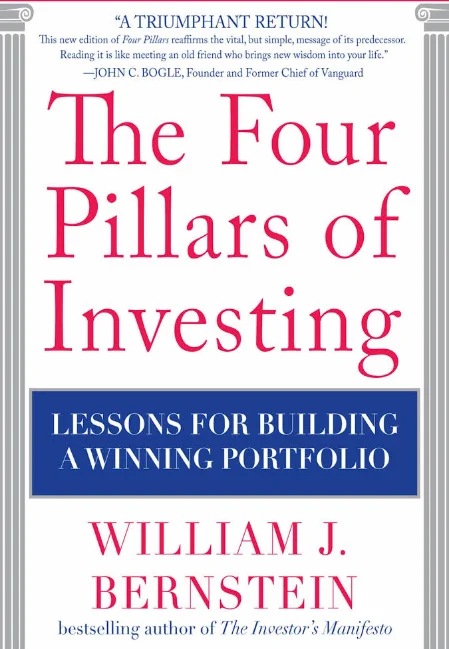
Author: William J. Bernstein
Pages: 352
Best for: Learning investment philosophy
William Bernstein is an American neurologist known for his work on Modern Portfolio Theory. His book, ‘The Four Pillars of Investing,’ is exceptionally useful for anyone looking to manage their own investment portfolio.
Instead of giving investment advice to make a quick buck, this book offers readers a unique view of market theory—how the market actually works, the history of markets, and the psychological aspects of markets. According to William Bernstein, the four pillars of investing are investment theory, history, psychology, and investment business.
9. The Little Book of Common Sense Investing
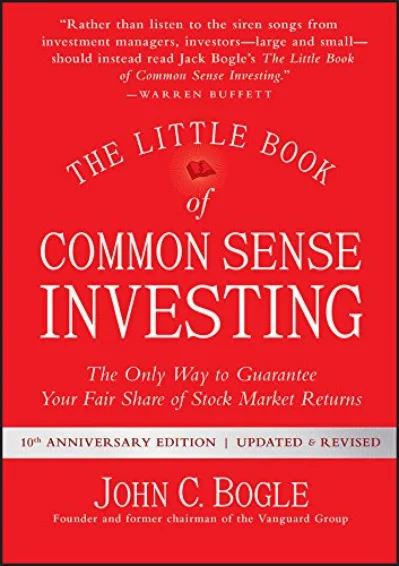
Author: John Clifton Bogle
Pages: 216
Best for: Index fund investing
What is the simplest and most efficient investment strategy for guaranteed stock market returns? According to John C. Bogle, the founder of Vanguard Group, the answer is low-cost index funds that hold the nation’s largest publicly traded companies.
No one is better than John Bogle at helping new investors learn how to use index funds in their portfolios and earn steady returns.
His book, “The Little Book of Common Sense Investing,” is enriched with in-depth analysis and advice that will guide you in adopting the same investment strategy that Mr. Bogle has relied on for decades.
8. Common Stocks and Uncommon Profits: Classic
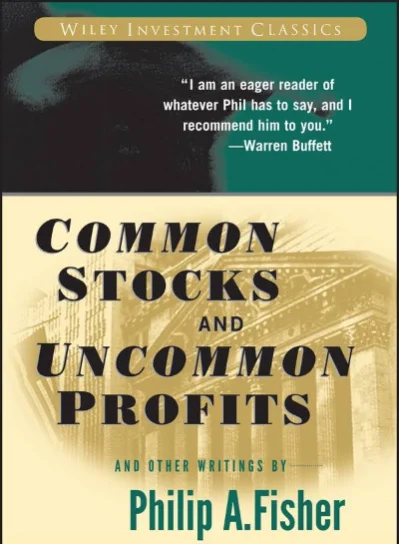
Author: Philip A. Fisher
Pages: 320
Best for Best for: Long-term investors
If you ask an investment professional or industry veteran about the best investing books, a few books are likely to pop out of their minds first, and Philip Fisher’s Common Stocks is one of them.
Philip Fisher’s investment philosophies are not only universally studied but also widely applied by bankers and financiers worldwide. Though originally written more than half a century ago, his book “Common Stock and Uncommon Profits” is highly valued in the modern investment industry.
If your goal is to invest in potentially great companies with excellent management, then this book is for you. In other words, this book will help you identify the future blue-chip stocks that are currently small.
7. Security Analysis
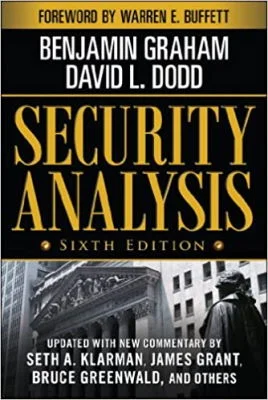
Author: Benjamin Graham, David L. Dodd, and Charles Tatham
Pages: 700
Best for: Finance professionals
Though Benjamin Graham’s Security Analysis was first published in 1934, it remains relevant even in today’s market. The book was co-authored by David Dodd and is currently in its sixth edition.
The two authors, who not only survived the Great Depression but also the fragile politics of the World Wars, urge investors to carefully estimate the rough value of a business before investing. Analysis of balance sheets is the first and foremost method to achieve success in the stock market. The book presents readers with other investment techniques and strategies that individuals can employ.
Several important financial terms that are in use today first appeared in this book. One such term is Margin of Safety, the difference between a stock’s intrinsic value and its market price.
“Security Analysis” is not your flamboyant investing book with flashy language. Instead, it is a textbook-style, comprehensive outlook on the stock market and investing, which may feel dry and hard to read at times. But a foreword by Warren Buffett and commentaries by several industry veterans alone make it a must-read by any aspiring investor.
6. The Elements of Investing
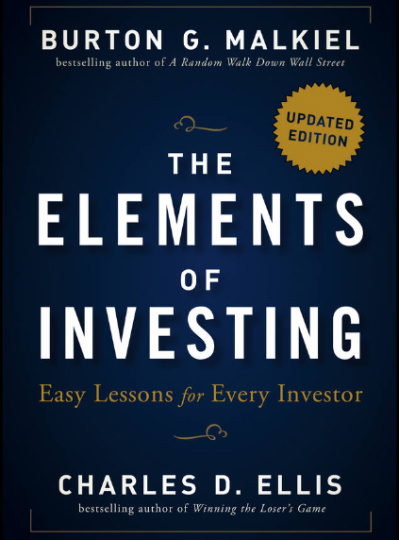
Author: Burton G. Malkiel and Charles D. Ellis
Pages: 182
Best for: Beginners
Perhaps two of the all-time best-selling finance authors, Burton Malkiel and Charles Ellis, teamed up to produce another masterpiece, “The Elements of Investing.” The book is focused solely on feeding average investors simple yet powerful ideas to achieve success in the market.
The book shows how, as an investor, you can tackle two of your biggest enemies: fear and greed. A disciplined approach and conviction are necessary to succeed.
5. Long & The Short of It

Author: John Kay
Pages: 82
Best for: New investors
“Long & The Short Of It” is a perfect book for people who are almost entirely new to the finance and investment field and are looking for expert guidance. (Not to confuse it with Les Binet and Peter Field’s book on marketing with an identical name).
John Kay is an esteemed economist who served as the first dean of Oxford’s Said Business School and was the former chairman of the London School of Economics. He has worked extensively on the UK’s equity market.
Kay’s “Long & The Short Of It” explains how to create and manage a portfolio. It emphasizes a long-term investment approach, diversification, and making your own financial decisions. This book can serve as a practical guide for new investors, as it covers the basic technical aspects of investing.
4. A Random Walk Down Wall Street

Author: Burton Malkiel
Pages: 464
Best for Learning market theories and practical investment strategies
Burton Malkiel is a noted economist who spent nearly three decades as a Director of the Vanguard Group, one of the world’s largest investment management firms. He currently serves as the Chief Investment Officer at Wealthfront Inc., an automated investment platform.
Over the years, Malkiel has written several influential articles and books on finance, and “A Random Walk Down Wall Street” is among them. The book summarizes Malkiel’s take on stocks, bonds, real estate investment trusts, as well as various tangible assets, such as gold.
It also does an excellent job describing (active) investing techniques and methods used by professionals. As of 2020, more than 1.5 million copies of the book were sold worldwide.
“A Random Walk Down Wall Street” is often cited by proponents of the efficient-market hypothesis, which states that asset prices are derived from all the publicly available information. It’s perhaps one of the top investing books you can have.
3. The Essays of Warren Buffett: Lessons For Corporate America
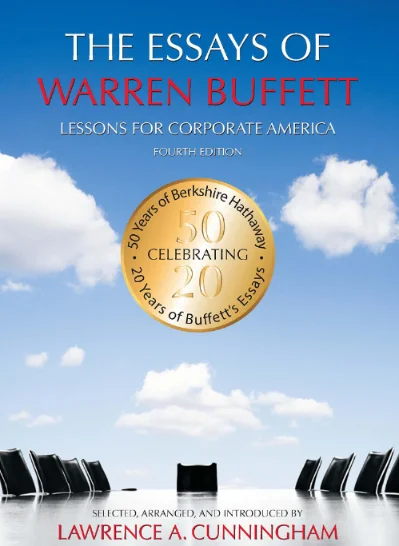
Author: Warren Buffett
Pages: 313
Best for New Investors
“The Essays of Warren Buffett” is a collection of hand-picked ideas and insights from the annual report letters by Warren Buffett to the shareholders of Berkshire Hathaway. As the world’s largest financial services company by revenue and one of the largest publicly traded corporations, you can only imagine how crucial these reports are.
To facilitate investors and readers with effortless access to the most critical bits or sections of these annual letters, Lawrence Cunningham, an American author (who is considered an expert on Buffett), selected and arranged them in a systematic order.
Apart from an overview of Berkshire Hathaway’s policies and future, the book contains deep insights into corporate finance/governance, common stock alternatives, mergers & acquisitions, and valuations.
2. One Up On Wall Street

Author: Peter Lynch and John Rothchild
Pages: 304
Best for: Identifying promising stocks
For a young investor, what could be better than learning the art of investing from a legendary money manager himself? Peter Lynch, the co-author of “One Up On Wall Street,” is one of the most prolific investors in the history of investment banking.
He served as a top manager at Fidelity Investments for more than a decade, between 1977 and 1990. Under his tenure, the Magellan Fund grew from just $18 million AUM (asset under management) to $14 billion. More importantly, the fund averaged a record-setting 29.2 percent annual return during that span, outperforming the S&P 500 index on most occasions.
One Up On Wall Street outlines Lynch’s investment ideas and strategies, which are largely inspired by the value-investing philosophy. It also gives readers insights into stock classification and how to streamline a portfolio, among other things.
In this book, Peter Lynch introduced the term “ten bagger,” referring to investments that have grown ten times their initial value.
1. The Intelligent Investor
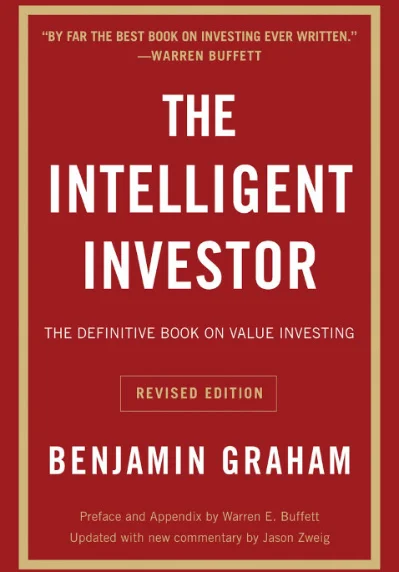
Author: Benjamin Graham
Pages: 640
Best for Value investing and long-term financial success
No list of best investing books is complete without the legendary “The Intelligent Investor.” Benjamin Graham is considered the most influential investing thinker of modern times. His investment principles are followed by some of the world’s most renowned investors, including Warren Buffett and Seth Klarman.
Graham has written multiple books on investing throughout his career, but none is more popular or influential than “The Intelligent Investor.”
Though the book was first published in 1949, multiple revisions over the years (the most recent in 2004, including Jason Zweig’s commentary) ensure its contents remain relevant.
Warren Buffett calls it “the best book about investing ever written.” What else do you need?
Why Trust RankRed?
To find the best investing books, we have reviewed more than 50 books by famous authors and finance professionals. We have considered recommendations from business executives, editors, and bestseller lists of global newspapers such as The New York Times and Financial Times.
Of course, the list includes some of our all-time favorites as well. Lastly, our site does not rely on paid articles or any kind of commission to generate revenue.
Read More


